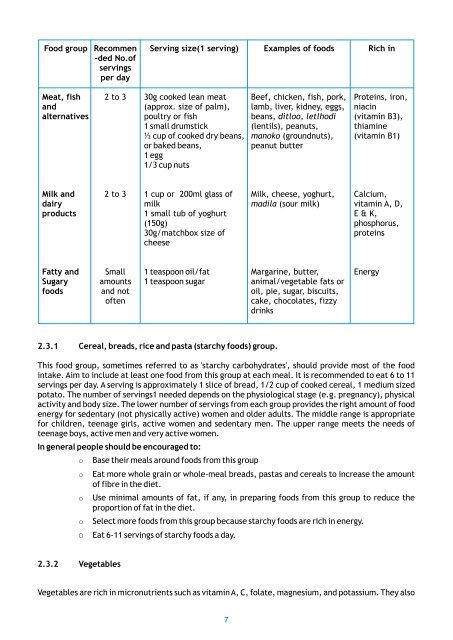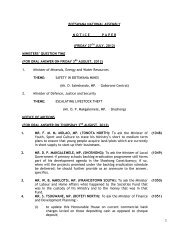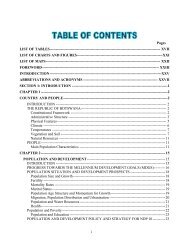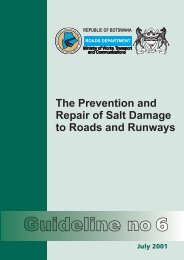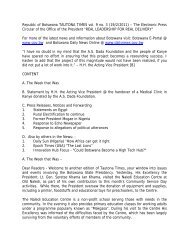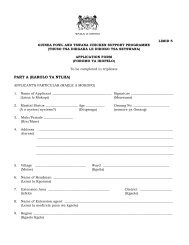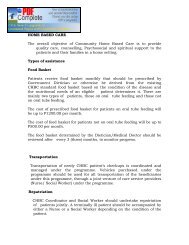National Nutrition and HIV/AIDS Guidelines for Service Providers of ...
National Nutrition and HIV/AIDS Guidelines for Service Providers of ...
National Nutrition and HIV/AIDS Guidelines for Service Providers of ...
You also want an ePaper? Increase the reach of your titles
YUMPU automatically turns print PDFs into web optimized ePapers that Google loves.
Food group<br />
Recommen<br />
-ded No.<strong>of</strong><br />
servings<br />
per day<br />
Serving size(1 serving)<br />
Examples <strong>of</strong> foods<br />
Rich in<br />
Meat, fish<br />
<strong>and</strong><br />
alternatives<br />
2 to 3<br />
30g cooked lean meat<br />
(approx. size <strong>of</strong> palm),<br />
poultry or fish<br />
1 small drumstick<br />
½ cup <strong>of</strong> cooked dry beans,<br />
or baked beans,<br />
1 egg<br />
1/3 cup nuts<br />
Beef, chicken, fish, pork,<br />
lamb, liver, kidney, eggs,<br />
beans, ditloo, letlhodi<br />
(lentils), peanuts,<br />
manoko (groundnuts),<br />
peanut butter<br />
Proteins, iron,<br />
niacin<br />
(vitamin B3),<br />
thiamine<br />
(vitamin B1)<br />
Milk <strong>and</strong><br />
dairy<br />
products<br />
2 to 3<br />
1 cup or 200ml glass <strong>of</strong><br />
milk<br />
1 small tub <strong>of</strong> yoghurt<br />
(150g)<br />
30g/matchbox size <strong>of</strong><br />
cheese<br />
Milk, cheese, yoghurt,<br />
madila (sour milk)<br />
Calcium,<br />
vitamin A, D,<br />
E & K,<br />
phosphorus,<br />
proteins<br />
Fatty <strong>and</strong><br />
Sugary<br />
foods<br />
Small<br />
amounts<br />
<strong>and</strong> not<br />
<strong>of</strong>ten<br />
1 teaspoon oil/fat<br />
1 teaspoon sugar<br />
Margarine, butter,<br />
animal/vegetable fats or<br />
oil, pie, sugar, biscuits,<br />
cake, chocolates, fizzy<br />
drinks<br />
Energy<br />
2.3.1 Cereal, breads, rice <strong>and</strong> pasta (starchy foods) group.<br />
This food group, sometimes referred to as 'starchy carbohydrates', should provide most <strong>of</strong> the food<br />
intake. Aim to include at least one food from this group at each meal. It is recommended to eat 6 to 11<br />
servings per day. A serving is approximately 1 slice <strong>of</strong> bread, 1/2 cup <strong>of</strong> cooked cereal, 1 medium sized<br />
potato. The number <strong>of</strong> servings1 needed depends on the physiological stage (e.g. pregnancy), physical<br />
activity <strong>and</strong> body size. The lower number <strong>of</strong> servings from each group provides the right amount <strong>of</strong> food<br />
energy <strong>for</strong> sedentary (not physically active) women <strong>and</strong> older adults. The middle range is appropriate<br />
<strong>for</strong> children, teenage girls, active women <strong>and</strong> sedentary men. The upper range meets the needs <strong>of</strong><br />
teenage boys, active men <strong>and</strong> very active women.<br />
In general people should be encouraged to:<br />
o<br />
o<br />
o<br />
o<br />
O<br />
Base their meals around foods from this group<br />
Eat more whole grain or whole-meal breads, pastas <strong>and</strong> cereals to increase the amount<br />
<strong>of</strong> fibre in the diet.<br />
Use minimal amounts <strong>of</strong> fat, if any, in preparing foods from this group to reduce the<br />
proportion <strong>of</strong> fat in the diet.<br />
Select more foods from this group because starchy foods are rich in energy.<br />
Eat 6-11 servings <strong>of</strong> starchy foods a day.<br />
2.3.2 Vegetables<br />
Vegetables are rich in micronutrients such as vitamin A, C, folate, magnesium, <strong>and</strong> potassium. They also<br />
7


